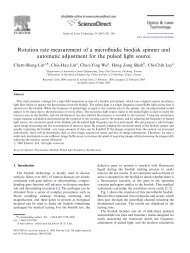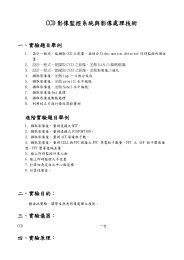Chern-Sheng Lin, Shi-Xiang Chan, Yun-Long Lay, Shiaw-Wu Chen ...
Chern-Sheng Lin, Shi-Xiang Chan, Yun-Long Lay, Shiaw-Wu Chen ...
Chern-Sheng Lin, Shi-Xiang Chan, Yun-Long Lay, Shiaw-Wu Chen ...
You also want an ePaper? Increase the reach of your titles
YUMPU automatically turns print PDFs into web optimized ePapers that Google loves.
228ARTICLE IN PRESSC.-S. <strong>Lin</strong> et al. / Materials Science in Semiconductor Processing 10 (2007) 227–234partial scanning mode. All the CCD functions can becontrolled manually or automatically using a computerthrough the RS-232C interface. The CV-M40CCD camera grabs the image of the target on theexperimental platform and passes it to a Corona-IIframe grabber for digitizing the image. The combinationof partial scanning and double-speed readoutwith progressive scan sensors was suitable for theinspection and measurement tasks in real-timedevelopment analysis.Among the parameters that effect photolithography,the most important are exposure and developmenttime, which effect the coating photoresistcharacteristics. During development, the contrast ofthe image will change with time [6]. The high-speedmicro photo measurement system has a CV-M40CCD camera with the frame-delay readout modethat reset the unsynchronization mode using anexternal trigger signal and eight different shutterspeeds set to control the exposure time. Thecontrolling speed for video readout is triggered byan external signal with different pulse lengths thatinclude three modes called normal readout, binningreadout, and partial scan. The timing diagramof the partial scan mode is shown in Fig. 1. Inorder to obtain high resolution of intensity distributionof each pixel accurately and effectively, thesetting control bias for the light intensity is in theimage-processing procedures. We divided the biasadjustment into four levels so that the total scalewill be 256 for brightness with 2 mm 2 mm visualfield.2. Imaging system designDuring the development processing operation,the designed chip or glass substrate is kept under theCCD camera, and the aperture as well as the focusis adjusted to obtain a sharp image. The images aregrabbed by the computer through the interfaces andthen analyzed. To confirm the distribution ofintensity from reflection in advance, we calculatethe intensity of reflection and transmission ray [7] bywave theory as shown in Fig. 2.We could get the s vector of reflectance by thewave theory:r ? ¼ n 1 cos y 1 n 2 cos y 2, (1)n 1 cos y 1 þ n 2 cos y 2where y 1 and y 2 are the incident and refractiveangle. n 1 and n 2 are the refractive indices of themedium.The p vector of oscillation reflex rate:r P ¼þ n 2 cos y 1 n 1 cos y 2. (2)n 2 cos y 1 þ n 1 cos y 2The s vector of transmission:2n 1 cos y 1t ? ¼. (3)n 1 cos y 1 þ n 2 cos y 2The p vector of transmission:2n 1 cos y 1t P ¼. (4)n 2 cos y 1 þ n 1 cos y 2The light source we used is not polarized. Theenergy from p and s vectors of light source is half ofExt.Trig0.1ms~40ms1HVIDEO OUTWEN(Positive)WEN(Negative)Effective readout line240 line120 line60 line30 lineExposuretimeA45H66H80H87HB240H120H60H30H1Hv.transferarefreezedC13H17H19H20HAValid periodB7HWaiting forExt.TriggerNote1:Sync or HD is not mentionedNote2:1H=31.777£gsNote3:WEN polarity can be chosen at JP22 of 1/F boardCFig. 1. The timing diagram of a frame-delay readout in the partial scan mode.





